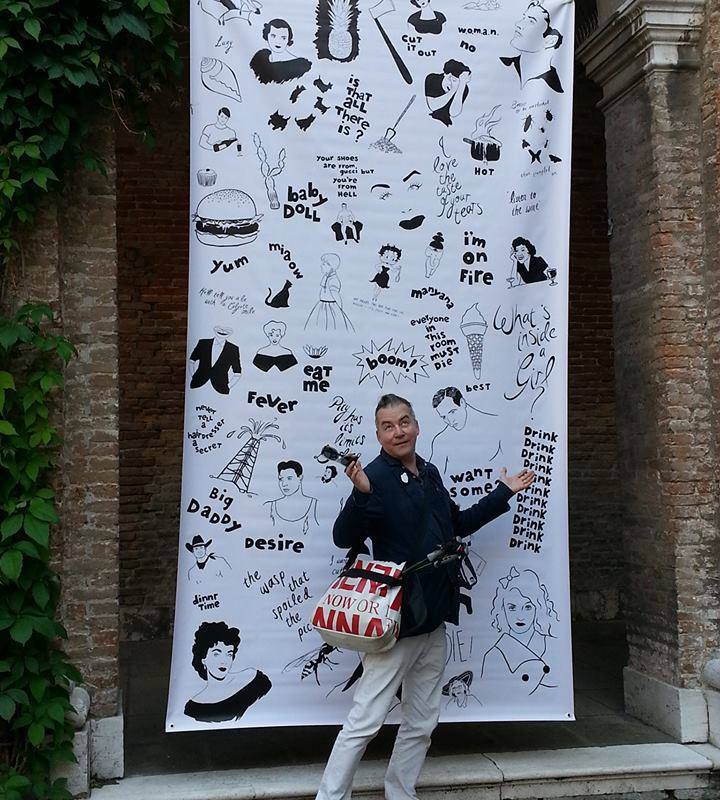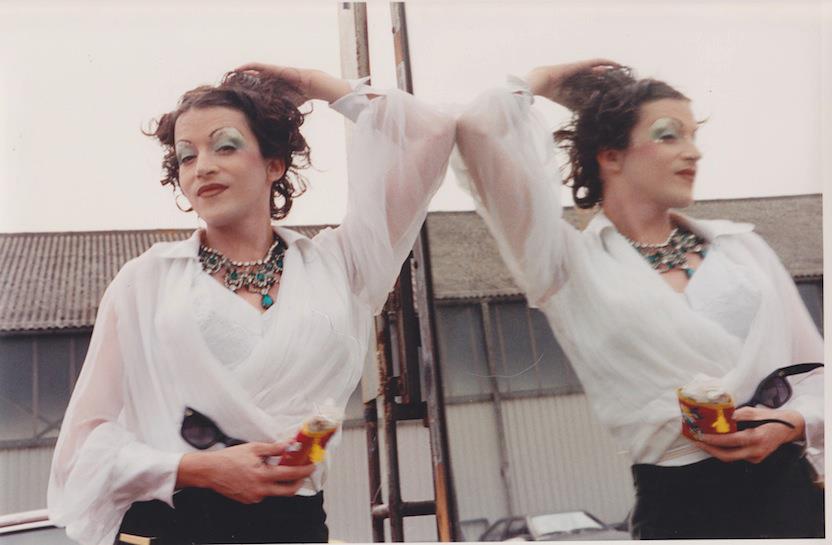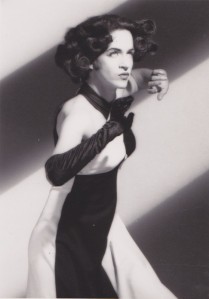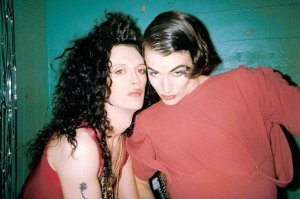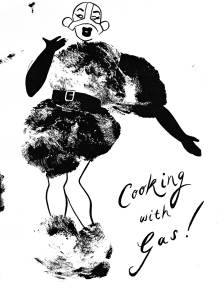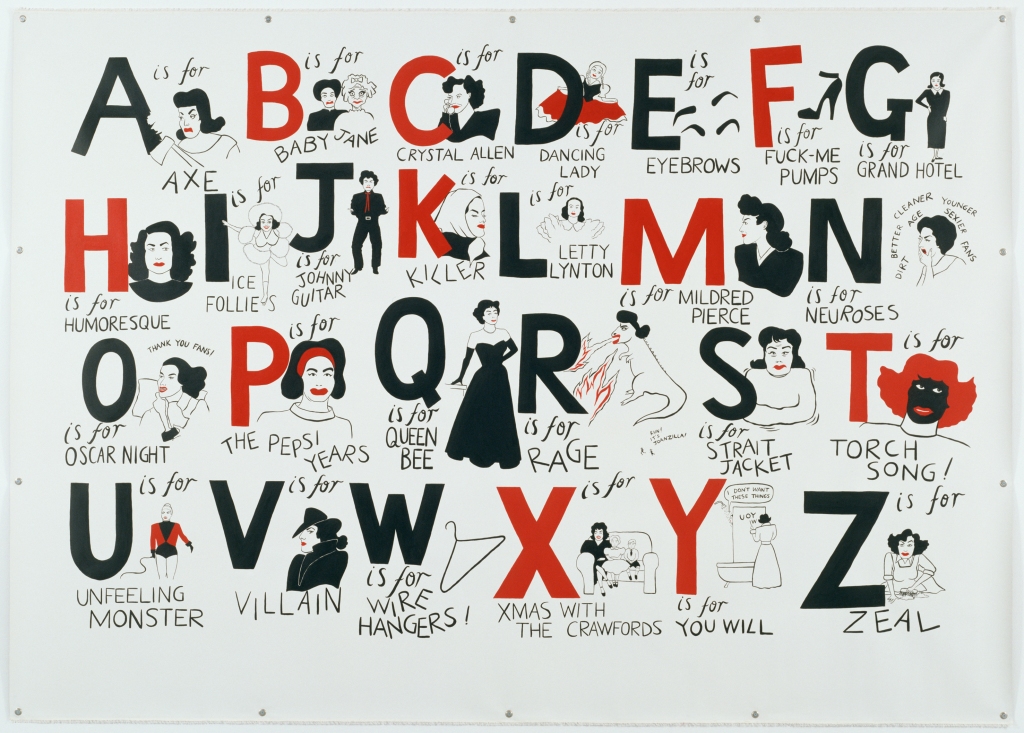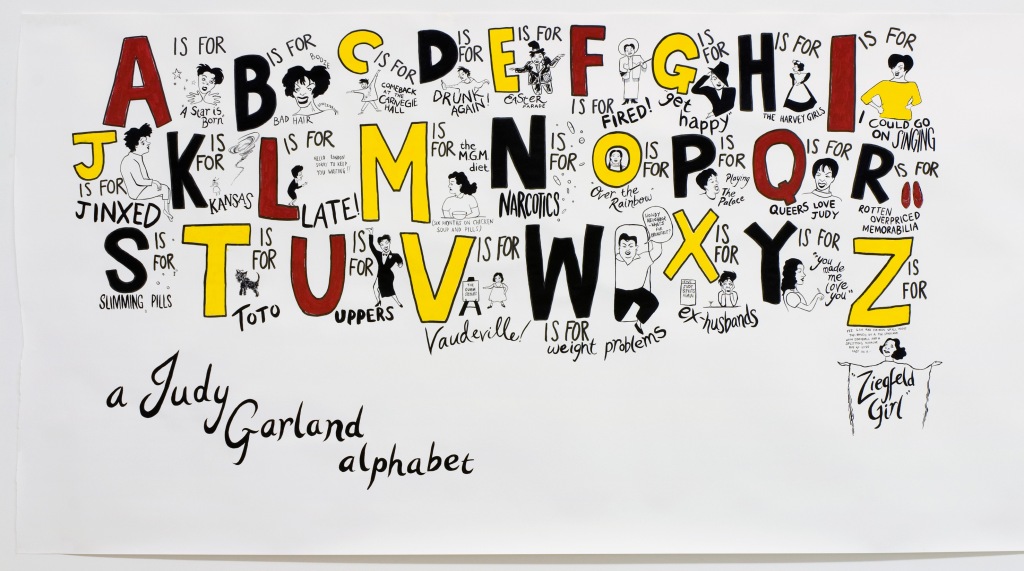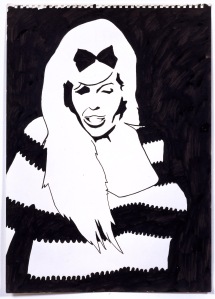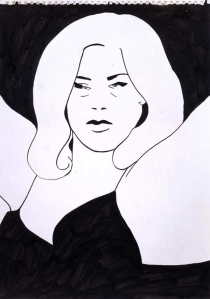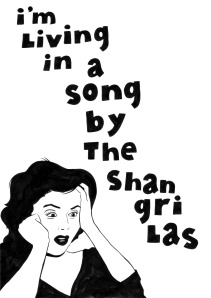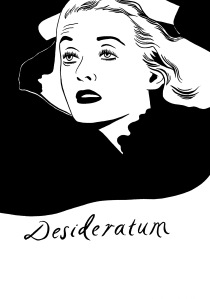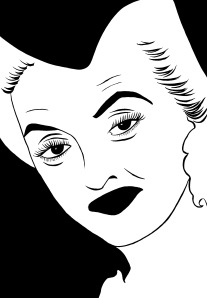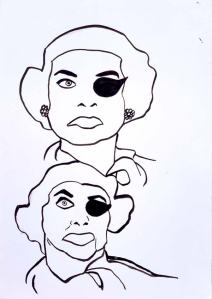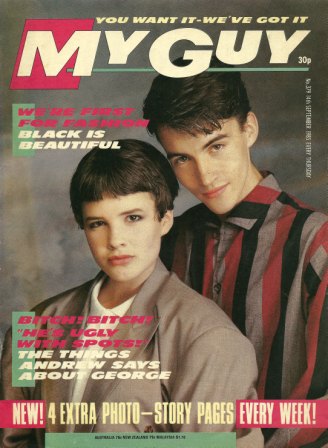If you look at Donald Urquhart’s art, it is no secret why we Ethel Mermaids should be obsessed with it. It’s not just the subject matters – full of Judy, Crawford, Bette Davis and queer references galore – but his precise style that gets to the heart of the matter and pulls you in with the joy and the pathos and the glory of it all. Urquhart is not just a great artist, however, but a vital part of the queer culture that goes back to before the Blitz Kid days. He is fascinating, funny and pure Mermaid gold. We couldn’t be more thrilled that he agreed to speak with us about his life, his work and the time he lived inside a Shagri-Las song…
What’s your background and how did you come to be an artist?
I grew up in Dumfries, Scotland and drawing was a means of escape from an early age. Becoming an artist has little to do with developing technical skills however; I feel it has more to do with developing sensitivity and humour – and I don’t mean the ha-ha kind of humour. How this cerebral arrangement forms is probably a combination of education and life experience. I was lecturing some art students a couple of years ago and told them that at 18-24 years old they shouldn’t be struggling through art degrees and getting heavily into debt when they could have been gaining experience and increasing their knowledge. When I was their age I didn’t have any opinions. I had nothing to say. So I became a fashion model and didn’t waste any paper on rotten art. Until I wanted to cause trouble.
You’ve written a great essay about your drag journey – or journey as a reality creator – and how in the 80s gay scene, drag was sneered at. How it developed for you seems at once organic and subversively stealth. What do you think of the drag scene today, in particular the ‘alternative drag scene’?
To be brutally frank I can’t stand any of the so-called alternative drag scene. Some of my friends are involved with that scene and I am glad that they are enjoying doing what they are doing. My pleasure ends there. You watch a lot of these acts and to avoid boredom it is sometimes entertaining to picture what is going on in their minds. “I’m in drag. Camp. I’m referencing The Cockettes with my beard. Fabulous. I’m miming badly. That’s the joke. What a laugh. Tits and a hairy chest. I’m so alternative. I love this song. I wish I could sing. I just want to be able to say I am a performance artist. My dream is Edinburgh or Glastonbury. I’m getting paid. Deep down I want to be the new Leigh Bowery or Boy George. When I get this lot off I can go down the sauna and nobody will suss I’m a tranny. Best of both worlds. I love it. Why is nobody clapping?”
The trouble with a lot of these people is they really want to become celebrities. What I was doing was the exact opposite. You can’t fake decadence. You can’t merely pretend to be nasty and offensive, you either totally destroy people and leave them with a complex that no amount of pills or therapy can cure or you are wasting their time and yours. This attitude will not get you a media job. This approach is certain to backfire and you will have no business in showbusiness. I got the sack from a few cabaret jobs. I was the warm-up at Gaytime TV who left them cold. The talent show judge who was “too judgemental” (I thought I would judge the contestants as people too). Even when Heaven asked me to sit on a throne at the door and be bitchy to everyone who came in (through a microphone) I was told I had gone too far and never worked there again. Well. They asked for bitchy. Something I said must have really hit a nerve.
Talking of your innovative cultural creation, you co-founded with Sheila Tequila and DJ Harvey the legendary club night The Beautiful Bend. There’s so much that came out of it: collaborations, performance, music. Do you miss it and that era? If you were to resurrect TBB for one night, who would be there, what would your outfit look like and what would the first song on the playlist be?
The Beautiful Bend goes wherever I go. I don’t know about missing those times as they are always with me in memories. Harvey came to Paris about a month ago and I met him at the gig. He is really up for doing another Beautiful Bend, or something that fuses our creativity – the only problem is that we are rarely in the same town for long these days. I’m still in touch with Sheila and we still have our two hour long highly bitchy phone chats. What I would love to do is have a Beautiful Bend with Sheila and Harvey. Just Sheila and Harvey. Turn up the music really loud and have sound effect of crowds laughing and cheering, glasses smashing, explosions. And have someone on the door telling everyone it is way too packed and nobody is allowed in, and everybody gets turned away. Crying all the way home.
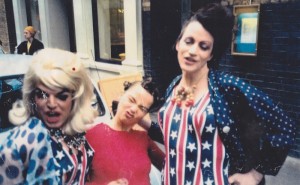
Actually I would invite Mr Pearl too. That would be really special. He loves swishy disco from 1978 so the first record we would play would be ‘Beautiful Bend’, which is Harvey’s favourite record and where we got the name from. I don’t know what I would wear. Hopefully Sheila would bring a few bags of shoes from 1978 and we could have a Shoe Parade. Just the four of us. We all have different sized feet (7,8,9,10) so there would be an element of Shoe Jealousy going on.
Much of your work is stylistically economical: either monochromatic or with few colours and measured lines, creating stark contrast with the flamboyant subject matters. You manage to distil the glamorous extravagance down to a few well-placed lines, skilfully capturing the essence of your subjects. Where do these stylistic choices stem from? What inspires your subject matter?
I’m very interested in Muriel Spark’s view of the novel as a short story that got carried away, and a short story being a poem that that somebody was too lazy or indulgent to distil down to its purest form. She was half-joking of course, but half-serious also. Nevertheless there is a truth there.
I am as much inspired by escaping reality as forcing people to face it. I suppose that “what inspires you?” and “who are your influences?” are stock questions in this sort of thing. The answer to both of them is ME.
You knew and collaborated with Leigh Bowery and were part of the 80s/90s alternative gay club/art scene. Leigh seems to have been a consistent part of your professional life since his death – for instance, you’ve assisted in archiving and curation of exhibitions, written about and created a zine about Leigh. He embraced simplicity and excess in equal measures. What are the meeting points in the worlds, sensibilities and artistic expressions of Donald Urquhart and Leigh Bowery?
In a similar way to Sheila, Leigh was one of my friends who was drawn to my descriptive powers and my love of detail. Leigh could stay on the phone for hours firing questions and I was always glad to relate the latest gossip, fleshing the scantest whispers of stories out into something a bit more lurid and grotesque.
We were both informed and encouraged by Scarlett Cannon, who was one of the most influential and inspiring people on the London club scene at that time. We were her boys and she was a sort of Miss Jean Brodie figure to us. “A celestial force for the good,” is how Pearl recently described her, recalling their first meeting at her club Cha-Cha’s.
We also were privy to an abundance of inside fashion and music information. You have to remember that we didn’t have the internet in those days so we physically had to go out and chat with as many people as possible. It was really exhausting usually, but we were young and nosey and hungry for cheap thrills – and serious pleasures.
I don’t know if you can tell that we shared a sick sense of humour? We also had a lot of time for the more extreme gay icons like Dorothy Squires and Danny LaRue. I can remember Leigh ringing me up, barely able to speak for laughing and playing a Live Dorothy Squires record down the phone. He laughed so much all through it that I could hardly hear it. Then he kept taking the needle back to the same place over and over again, but all the while tittering and laughing so I couldn’t hear it. He finally said “are you getting this in the VAN?” Squires was drunk on stage somewhere in Wales and she had a van parked outside recording her performance for posterity. I used to play Danny LaRue down the phone to him. You have to see LaRue’s film ‘Our Miss Fred’ – that is totally where Leigh got most of his moves and poses from. The fantasy fashion show sequence is 100% Bowery – the audience are all in Nazi uniform. Too much.
I was very lucky to have known Leigh from 1983 up to his death. I watched him transform from a slightly bashful lad with an Aussie twang, through ever more extreme fashions and attitudes, to his rather grand final incarnation. His voice was total Royal Shakespeare Company eventually. Of course the whole time we were sure we were going to die young, because everybody was always dying. That was what drove our flamboyant decadence. Every party was going to be our last. I do find it strange that eighteen years after Leigh’s death I am still here. As are a large number of our contemporaries. The dying pretty much stopped after Leigh died – but not entirely of course. The era of frequent funerals was harrowing all the same. I remember thinking to myself ‘Another funeral. Another graveyard. Another wake. Who’s next?’
Your Alphabet series is brilliant. Unsurprisingly, we’re particularly drawn to your Joan and Judy Alphabets. They capture the camp, humour and iconology of the subjects; what keeps us hooked on them and why they are so fascinatingly delightful. Will there be any more alphabets in the future? If so, can you let us in on who or what you may be alphabetising?
I daresay there will be other alphabets. I’m not the kind of artist who can just roll their sleeves up and pick up a brush and whistle as they knock things out. I really have to find the right mood and become focused. The alphabets take a lot of planning and research. You have 26 alphabetically ordered points in which to describe your subject. Some letters are more difficult than others. I had a really tough time with my Margate Alphabet. The hardest letter was ‘O’.
I’m reading a biography of Tallulah Bankhead right now and although she would seem good material for an alphabet there seems to have been way too much going on in her life to nail her in 26 letters. Twenty six four letter words might be better.
To paraphrase one of your wonderful art works, ‘the faggots love Judy’. Some lady-faggots love them some Judy too. She appears in a lot of your work. What, for you, is the queer appeal of Garland?
‘Those faggots love to GET HAPPY with Judy – but is their happiness REAL?’ – I think I have seen enough feigned happiness on the gay scene to make Pollyanna retch. You know when somebody pulls a really huge smile – all bared teeth – but their eyes are desperately searching for your approval? If you don’t smile back instantly they start to feel insecure and wonder if you hate them. Rather than going into the danger zone of looking at themselves and working out what it is you might not like about them, they try to turn it around onto you. “Are you alright? What’s wrong? You don’t look happy.” – “I’m not happy because you are grinning in my face. Go away.” How shallow are some people? We all have to go around beaming like junk jewellery or we’re killjoys. I’d love to be able to explain my lack of expression by saying “I’m the president of the Virginia O’Brien Fan Club” but would they get it? Hell, I’ve met queens that have never heard of Coral Browne.
For me the queer appeal of Garland is simply that she was camp and could be very bitchy. She was hilarious. Other gay people cling teary-eyed to poor little Dorothy singing ‘Over the Rainbow’ as though her sadness is theirs too. That’s the thing – there were many Judys. She was no one-trick pony. There’s a Judy for everyone. Pill poppers, drunks, fag hags, lesbians, fats, anorexics, the bitter, the disillusioned, the brave, the weak… One Judy fits all.
There’s nothing quite like a train-wreck, tarnished or tragic blonde. How did you select those depicted in your Peroxides on Parole series? What do they mean to you? Do the contemporary crop of notorious blondes measure up to the cracked legends of these women? (Spears, Lohan, perhaps even Courtney Love immediately spring to mind).
Strangely I made those drawings by freeze-framing video tapes and then drew the sometimes distorted faces that jerkily flickered on the screen. So it was really down to which blondes I had video tapes of. Drawing with black ink on white paper, people only have black hair or white hair. There are no redheads or brunettes. There is something about a peroxide blonde that makes her a little shadier than a natural blonde. Like Kim Novak in ‘Vertigo’ or Tippi Hedren in ‘Marnie, she is a fake with something to hide as well as someone who goes to great pains to stand out.
I have no interest in Britney Spears. I might change my mind when she dies. Ditto Lohan. Courtney Love is more interesting, coming from the same trash pile as Pete Burns but she could try harder. Or maybe people could try harder to boost her “career”. I think she has great potential. Which is like saying I pity her for failing.
One piece of peroxide I am shocked has not gone further is Margi Clarke. Can you believe she is working in a pub? At a ‘Fur Is A Drag’ night in Heaven I shared a dressing room with her and Chrissie Hynde. Chrissie was a bit nervous as she wasn’t used to singing along with a pre-recorded vocal. I thought a spliff might help but Chrissie started worrying about what she was wearing. It was a black lace shirt with a black waistcoat and black jeans. “Is this OK? – I mean. I NEVER wear black!” she said in all seriousness. Margi was set to model an apron which read “I’d Rather Go Naked Than Wear Fur” – but she was wearing a very obvious black bra and panties underneath. I tried to dissuade her. She wasn’t having it. Then I pointed out that she was going out in front of a thousand queens in a bra that was too small for her and caused fat to hang over it at the sides and back. Before I started on the panties she whipped her undies off. “You’re right,” she said, “and thanks. I’m going to get a new bra.”
You have the choice to spend an evening at the home of Joan Crawford or an evening on the town of Judy Garland. Who do you go with and why?
An evening at the home of Joan Crawford without her being there – where I could snoop through her wardrobe and sex toys. That appeals to me, but I don’t know that I would have found her as entertaining company as a sozzled Judy out on the town. I’d go and get rat-arsed with Judy and sing all the songs.
In the mid 1980s I lived next door to a sweet old gay couple. They had both worked in the hotel trade all their days. They had met them all: Liz, Grace, Ava… One night they had been at a gay party in Chelsea. They came out and the first thing they saw was a woman lying drunk on the road. It was Judy Garland. They couldn’t rouse her – she was totally out of it. So one of them ran to a phone box and rang round all the hotels to find out where she was staying. Then they bundled her into a taxi and took her back. Their proudest possession was the signed photo and thank you note she sent them. A true star. If I had to choose between suffering the agonies of Judy Garland’s heart or Joan Crawford’s vagina I know which one I would pick. Christina! Fetch me my Fuck-Me pumps!
We love a zine and are all zinesters here. I see the zine-as-art-object fucking with ideas of high and low culture and, for me, so much of your work is doing that. What do you like about the zine format and what are your thoughts about DIY cultural production in general?
I see the zine as something easy to produce. All you need is a typewriter and maybe material for collage, access to a photocopier – and away you go. You don’t need a computer or anything complicated.
I used a brush (never a pen) with black ink for drawing as the photocopier reads this clearly. I didn’t rub out pencil marks as the crummy photocopier at my local post office wasn’t sophisticated enough to pick them up.
The most important aspect of a zine is quality of content. Otherwise don’t waste paper. If you are making a zine for your own entertainment just make the one and stay home.
Which Shangri-Las song do you live in?
I was going through a hell and high water seaside romance. It was really more draining than fulfilling, and one bleak morning it struck me that I was trapped in some melodramatic Shangri-Las Song – or all of them. I made that drawing and then it was turned into a print to raise funds for the Whitechapel Gallery. By the time I had got the prints my on/off boyfriend had decided that we should be “partners” as he called it. We were going steady at last. I gave him a signed print and told him that he had inspired the drawing. “Which Shangri-Las song were you thinking of?” he asked, looking quite flattered.
-“One of the ones where they both die in a horrible car accident at the end.” The look on his face told me that our love was doomed.
On the 8th August The Ethel Mermaids will be present, in Joan-drag and hawking our stuff, at Amy Grimehouse Presents Mommie Dearest. What’s your take on the book and film, and: will Donald Urquhart be in London to accept an invitation to come along too?
I don’t know what I’m doing in August. Paris closes down so there isn’t much point in me being here. I’ll certainly come along if I’m in town. With an axe.
I met Faye Dunaway just after Mommie Dearest came out. She used to shop in a fashion store I worked in called Jones. She had a whole running rail of things she had put on hold. She was lovely, but the problem with her was that she was always “in disguise”, you know – big dark glasses, floppy hat, long crochet waistcoat. Total spy garb. Nobody was meant to know who she was. She had a thing about Katherine Hamnett menswear. The trousers were no good as they didn’t fit but she loved the parachute silk shirts and poplin jackets. Once she got very excited about a red shirt, “I remember when Katherine was designing this!” she exclaimed before checking herself with “but that is giving the game away…”
What game? Was this a game? It probably was. In all the time I had spent serving her she hadn’t actually purchased anything. What I didn’t know was that she really hated the film. One afternoon I was unpacking a box of new jackets that had just arrived, and hanging them on the rails. Enter Dunaway, in mufty as usual. Smiling I said “You will be pleased to know, Miss Dunaway, that we only use wooden hangers in this store.”
Through her tinted shades I saw her eyes widen, her mouth turned down at the corners. It would have been great if she had yelled “NO… WIRE HANGERS…EVER!!” but she turned on her heel and stomped out in a fury without saying a word. I don’t know if she came back to the store as I was “made redundant” about a week later. I suspect because of her.
What was the question? Oh yes, Mommie Dearest, the never ending story of Big Bad Joan Crawford as told by her abused daughter. Christina has brought out a few extended versions which I haven’t read. I remember she had a blog that may as well have been called “And ANOTHER thing!” – she always has that bit more energy to spare for hammering another nail into Joan’s coffin. In her most recent tour she made no bones about hinting that Joan was responsible for Albert Steel’s death while answering a question from a fan. Did Joan really throw him down the stairs or was Christina remembering a scene from one of Joan’s movies?
The book may well be a memoir written out of revenge and skewed by a defective memory. B.D. Hyman’s ‘My Mother’s Keeper’ was a copycat effort by Bette Davis’ daughter to cause her mother pain. It did. They never spoke again. At least Christina waited until the bitch was DEAD.
For an illustrated edition of Vanity Fair you chose the sublime Bette Davis as your Becky Sharpe. Why was Bette so useful for this project?
I was originally only going to show the key female characters, in an homage to George Cukor’s ‘The Women’. By way of homework I watched the film ‘Becky Sharp’ – the first colour movie – which was based on Vanity Fair. I really didn’t think that shrill Miriam Hopkins made a convincing Becky. She is great in some scenes but I thought that Bette Davis would have been much better. Davis and Hopkins loathed each other, and I decided to use Davis as my model for Becky Sharp – sort of a revenge from beyond the grave.
In the book Becky first appears as a schoolgirl and at the by the end we don’t really know her age but it is clear that she has let herself go to a great extent, so I drew Davis going from fresh-faced ingénue to Baby Jane – and beyond. I think any reader with knowledge of Bette Davis films could easily imagine her in the role.
Bette appears elsewhere in your work, for instance the incredible Davis Scowl depicting Bette in The Anniversary. Do we have your permission to get a tattoo artist to put your Bette on our Becky (Mermaid)?
I think that’s a lovely idea. I’d really like to see the end result – depending on where the tattoo is. She’s not going to have her eyeballs done is she, so that she has ‘Bette Davis Eyes’?
All images courtesy Donald Urquhart, Herald Street and Maureen Paley galleries
